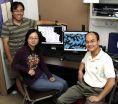(Press-News.org) Boston, MA -
The Tufts Clinical and Translational Science Institute (CTSI) today issued a landmark report from a multi-state study on psychotropic medication oversight in foster care. Led by Laurel K. Leslie, MD, MPH at Tufts CTSI, Christopher Bellonci, MD at Tufts Medical Center and Justeen Hyde, PhD at Cambridge Health Alliance, the study examined state policies and practices in 47 states, including Massachusetts, and the District of Columbia regarding the use of medication for treating behavioral and mental health problems in foster care children and adolescents ages 2 to 21 years.
Over the past decade, psychotropic medication use in the general youth population has more than doubled. Estimated rates of psychotropic medication use in foster care youth, however, are much higher (ranging from 13-52%) than those in the general youth population (4%).
In 2008, President Bush signed into law the Fostering Connections to Success and Increasing Adoptions Act, which requires state child welfare agencies and Medicaid to provide ongoing oversight and coordination of medical and mental health services, including psychotropic medications, for youth in foster care. Since then, state child welfare agencies have been working to develop sound policies and practices for this population of kids.
The Tufts CTSI multi-state study, begun in 2009, concluded that while oversight of psychotropic medication is a high priority of the state child welfare agencies, there is also great variability among the state policies and practices governing such oversight. The Study Report calls for a national approach and resources for medication oversight for youth in foster care. A more detailed national look at which state policies and practices are the most effective for improving the mental health of these youth is also needed. Without a national approach, crossing a state border could mean the difference between a youth in foster care being appropriately treated with medications or not. The report also stresses the need for youth-serving organizations and state agencies to work together, and for more informed decision-making and appropriate medication monitoring for youth in foster care.
The majority of states in the multi-state study reported an increasing trend in the use of psychotropic medications among youth in foster care, specifically regarding: Increased use of antipsychotics, antidepressants, and attention-deficit hyperactivity disorder (ADHD) medications;
Increased polypharmacy (the use of more than one psychotropic medication at the same time); Increased medication use among young children; and Increased reliance on giving medications "as needed" and "blanket authorizations" for such drug use in residential facilities.
Officials in some states felt that this increase partially reflected demand by foster parents, schools, and other stakeholders. Others felt that reimbursement and time pressures in the healthcare system encouraged medication use. A few states, however, indicated a decrease in medication use in their states and thought that these changes reflected policy and practices implemented over the last several years.
Many child welfare officials understood that medication plays an important role in addressing mental health problems. However, officials were concerned that medications were being used to manage problems that might respond as well, or better, to psychosocial treatments.
Funded by the Charles H. Hood Foundation and the National Institute of Mental Health-funded Child and Adolescent Services Research Center in San Diego, the study involved interviews with state child welfare agency key staff as well as a review of existing policies and guidelines available on state public websites or provided by staff. The Study Report and specific tools developed by states are available online at http://www.tuftsctsi.org/About-Us/CTSI Components/Community-Engagement.aspx. The Study Report was funded by the William T. Grant Foundation and Tufts CTSI.
States that participated in the study include: Alabama, Alaska, Arizona, Arkansas, California, Colorado, Connecticut, Delaware, D.C., Florida, Georgia, Idaho, Illinois, Indiana, Iowa, Kansas, Kentucky, Louisiana, Maine, Maryland, Massachusetts, Michigan, Minnesota, Missouri, Nebraska, Nevada, New Hampshire, New Jersey, New Mexico, New York, North Carolina, North Dakota, Ohio, Oklahoma, Oregon, Pennsylvania, Rhode Island, South Carolina, South Dakota, Tennessee, Texas, Utah, Vermont, Virginia, Washington, West Virginia, Wisconsin, Wyoming.
###
About Tufts Clinical and Translational Science Institute (CTSI)
www.tuftsctsi.org
Tufts CTSI was established in August 2008 with Grant Number UL1 RR025752 from the National Center for Research Resources (NCRR), National Institutes of Health (NIH). A collaboration of organizations, founded by Tufts Medical Center and Tufts University, Tufts CTSI accelerates the translation of laboratory research into clinical use, medical practice and health policy. It connects people to research resources, consultation, and education, and fosters collaboration with scholars of all disciplines and with community members, with the ultimate goal of improving the health of the public.
About Tufts Medical Center
www.tuftsmedicalcenter.org
Tufts Medical Center is an exceptional, not-for-profit, 415-bed academic medical center that is home to both a full-service hospital for adults and Floating Hospital for Children. Conveniently located in downtown Boston, the Medical Center is the principal teaching hospital for Tufts University School of Medicine. Floating Hospital for Children offers a comprehensive range of services from prevention and primary care to the most sophisticated treatment of rare and unusual conditions. The hospital's focus and mission every day is to improve the lives of children and their families.
About Tufts University
Tufts University, located on three Massachusetts campuses in Boston, Medford/Somerville, and Grafton, and in Talloires, France, is recognized among the premier research universities in the United States. Tufts enjoys a global reputation for academic excellence and for the preparation of students as leaders in a wide range of professions. A growing number of innovative teaching and research initiatives span all Tufts campuses, and collaboration among the faculty and students in the undergraduate, graduate and professional programs across the university's schools is widely encouraged.
END
Researchers from Utrecht University who studied the effect of negative emotions on pain perception in women with and without fibromyalgia found that anger and sadness amplified pain equally in both groups. Full findings are now online and will publish in the October print issue of Arthritis Care & Research, a journal of the American College of Rheumatology.
Fibromyalgia (FM), a chronic pain condition, has among the largest impact of all rheumatic and chronic pain conditions. In addition to chronic, widespread pain, patients report accompanying symptoms such as fatigue, ...
New research has found that a genetic variant which reduces the chance of contracting diseases such as tuberculosis and leprosy is more prevalent in populations with long histories of urban living.
The research, published in the journal Evolution, shows that in areas with a long history of urban settlements, today's inhabitants are more likely to possess the genetic variant which provides resistance to infection.
In ancient cities, poor sanitation and high population densities would have provided an ideal breeding ground for the spread of disease. Natural selection ...
In many developing countries, the absence of surface-based air pollution sensors makes it difficult, and in some cases impossible, to get even a rough estimate of the abundance of a subcategory of airborne particles that epidemiologists suspect contributes to millions of premature deaths each year. The problematic particles, called fine particulate matter (PM2.5), are 2.5 micrometers or less in diameter, about a tenth the fraction of human hair. These small particles can get past the body's normal defenses and penetrate deep into the lungs.
To fill in these gaps in surface-based ...
AMARILLO - Wheat streak mosaic virus is the most prevalent disease in the southwestern wheat producing region of the U.S., according to a Texas AgriLife Research scientist.
Dr. Charlie Rush, AgriLife Research plant pathologist in Amarillo, is assembling several teams of scientists to work on the disease from every aspect: vector to diagnosis and mapping to control.
"There are other diseases of concern, but wheat streak mosaic is always found somewhere in this wheat growing region, and every couple of years, we have an epidemic of it," Rush said.
Several issues cause ...
DURHAM, N.C. – While scientists have spent the past 40 years describing the intricate series of events that occur when one mammalian cell divides into two, they still haven't agreed on how the process begins.
There are two seemingly contradictory theories, which now may be reconciled by a third theory being proposed by Duke University bioengineer Lingchong You. These findings could provide insights into the initiation of disease, such as cancer, which is marked by uncontrolled cell proliferation.
During proliferation, the DNA within the nucleus of a cell makes a copy ...
AMES, Iowa – A research team led by Edward Yu of Iowa State University and the Ames Laboratory has discovered the crystal structures of pumps that remove heavy metal toxins from bacteria, making them resistant to antibiotics.
The findings are published in the Sept. 23 issue of the journal Nature.
Yu – an Iowa State associate professor of chemistry, of physics and astronomy, of biochemistry, biophysics and molecular biology and an associate of the U.S. Department of Energy's Ames Laboratory – said the finding gives researchers a better understanding of bacterial resistance ...
MANHATTAN, KAN. -- With the concept of a store-within-a-store growing across the country, a Kansas State University researcher's work shows the increasing importance of brand reputation and its strong role in governing decisions.
Richard McFarland, associate professor of marketing, and four colleagues recently completed "Understanding Governance Decisions in a Partially Integrated Channel: A Contingent Alignment Framework." Their research will be published in the elite Journal of Marketing Research next year.
The research looks at separate companies who entered a store-within-a-store ...
A team from the National Museum of Natural Sciences (CSIC) has analysed the impact of climate change on spotted hyena survival in Europe over 10,000 years ago. These changes played an important role, but the scientists say studies are still needed to look at the influence of human expansion and changes in herbivorous fauna on the definitive extinction of this species across the continent.
"Climate change in the past was not directly responsible for the extinction of the spotted hyena in southern Europe, but it was a factor in its disappearance", Sara Varela, lead author ...
GREENBELT, Md. -- New supercomputer simulations tracking the interactions of thousands of dust grains show what the solar system might look like to alien astronomers searching for planets. The models also provide a glimpse of how this view might have changed as our planetary system matured.
"The planets may be too dim to detect directly, but aliens studying the solar system could easily determine the presence of Neptune -- its gravity carves a little gap in the dust," said Marc Kuchner, an astrophysicist at NASA's Goddard Space Flight Center in Greenbelt, Md. who led ...
"A giant rhino with a ridiculously supersized head."
"Fifteen long, pointed sideways oriented eye horns: one over the nose, one atop each eye, one at the tip of each cheek bone, and ten across the rear margin of the bony frill."
"A horned face: large horn over the nose and short, blunt eye horns that project strongly to the side."
Such phrases have been used to describe two newly discovered species of dinosaurs with looks only a mother could love. Still, they are drawing the attention and inspiring the imagination of scientists and lay people alike.
Announced today ...


